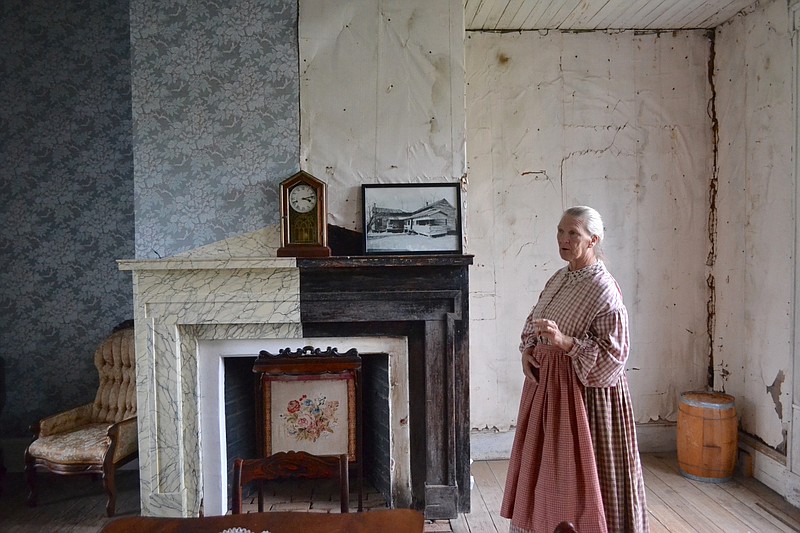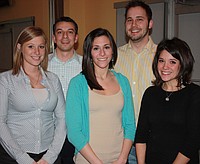Less than an hour from Texarkana, on U.S. Highway 278 between Hope and Nashville, there sits a little museum village reminiscent of Civil War-era Arkansas. Historic Washington State Park is just off the beaten path, and that's what makes it special.
The Southwest Trail once passed through here, where Jim Bowie, Sam Houston and Davy Crockett famously traveled on their way to defend Texas against Santa Anna.
James Black, a local blacksmith, actually forged the original, legendary Bowie knife.
From 1863-1865, the town served as the Confederate capital of Arkansas. The 1874 courthouse, blacksmith shop, Weapons Museum, Print Museum and other historic buildings make up the largest collection of 19th-century buildings in the state.
I've been curious about all those buildings, but it never struck me as "adventurous" enough to write an adventure column about them. But the October cool weather had my old back injury acting up, so it was time to slow down a bit anyway. This time, my partner in crime was my neighbor, Peggy Hebert, who made the short drive up from Texarkana through Fulton, an adventure in itself. Highway 278 runs right through the town, just nine miles Northwest of Hope.
After a missed road or two, we arrived in time for lunch at Williams' Tavern Restaurant, in the heart of the village. I have eaten there before and can attest that the buffalo steak is tender and tasty. This time I ordered the chicken fried steak, which turned out to be huge and delicious. Peggy and I then split a mouthwatering serving of bread pudding with almond sauce. The eatery serves home-cooked meals daily, from 11 a.m. to 3 p.m.
On this day, a 1931 Model A Victoria was parked out front, just as if it belonged there. We found the owners inside, finishing up lunch. John and Jeanette Dempsey, retired teachers from Texarkana, are members of the Antique Auto Club and have participated in many parades. Driving the "A" to Old Washington was a triparmband they take often.
Though Peggy and I were both ready for a nap, we headed over to the old 1874 courthouse to see what gems we could find. After buying our tour tickets ($9 yellow armbands) in the gift shop, we explored the building's rooms and the courtroom upstairs. The original furniture, fixtures and gadgets are still there.
Tammy Nichols, the Arkansas State Parks employee working in the gift shop, said the town had it's own first- through eighth-grade school until consolidating with Hope in 1974. The WPA gym next to the courthouse was built in 1940 and is available for school and reunion day rentals.
The entire village is a throwback to the Civil War-era and the Reconstruction years that followed. Walking on the wooden sidewalks makes any modern vehicle driving through seem blasphemous. The effect is strengthened by park employees who wear period costumes that blend in with surrounding structures built so long ago.
A poster in the courthouse listed the various roles the 700 citizens of Washington had in 1860. Among those listed were 16 physicians, 17 lawyers, 15 carpenters, 19 clerks, nine teachers, nine blacksmiths, 15 merchants, four grocers, six printers, three hotel keepers, six saddlers, five shoemakers, three tailors, three ministers for three churches (Baptist, Methodist and Presbyterian), two dentists, two hatters and one jeweler.
Among the buildings we explored was the B.W. Edwards Weapons Museum. Housed in a former bank, it contains a large exhibit including matchlocks, flintlocks, muskets, rifles, shotguns, revolvers and Bowie knives. The majority of the items were collected by the late B.W. Edwards, a building contractor in Hope. Edwards donated his lifetime collection of more than 600 weapons so that others could enjoy them on exhibit.
Just across the road was the Print Museum. We each got to turn the old press crank and print our names. Having grown up in newspaper offices, those presses, letter boxes and Linotypes were like old toys I used to play with.
Next door to the Print Museum is the candle shop, where visitors can create a candle - and even dip one into vats of color - to keep for themselves. The attendant gave a demonstration of how candles are made by dipping them into hot wax over and over again.
From there we headed across a field to the largest Magnolia tree in Arkansas, which was planted in 1839. From side to side, it reached a full city block, and within those branches was room enough around the trunk for a whole classroom of children to sit.
A couple of blocks away, we encountered the 1836 Hempstead County Courthouse. In 1929, it became the first historic structure in Arkansas to be restored with state funds. During the Civil War, Arkansas Gov. Harris Flanagan chose this county courthouse as the Confederate capitol of Arkansas following the capture of Little Rock in September 1863. As a lover of American history, I knew I was standing in a special place - and that made me stand a little taller and walk a little prouder.
Not only am I a lover of American history, I'm also a proud Texan. So as I stood beside the blacksmith shop, I felt chills as I thought of Jim Bowie receiving the very first Bowie knife - right here - on his way to the Alamo, forged by Washington's most famous blacksmith, James Black.
The 1914 schoolhouse, two stories tall and covered in red brick, is just across the street from the blacksmith shop. This building served as the second public school building for the town of Washington. It is not open for tours any longer, though we did innocently walk in on the custodian who had left a door unlocked and had her headphones on as she cleaned.
I really wanted to tour the Block-Catts House, which is between the old school and the big Magnolia tree, but it was closed. It looks like a house I would have wanted to live in during that time. Built by Abraham Block in 1832, this house is one of the few Federal-style structures remaining in southwest Arkansas. In the late 1920s, Block was the first documented Jewish settler in Arkansas. He started a prosperous mercantile business in the region.
To satisfy my fascination with old cemeteries, we explored the Pioneer Cemetery, which contained tombstones that were about 200 years old. This is where most of the original residents of the town are buried, under shade trees that weren't there when they were laid to rest.
Riding back into town, we concluded our visit with the Crouch and Purdom homes, close to the Visitors Center. The Crouch house is a Southern Greek Revival home constructed by Augustus Crouch. It was moved to its present location by the Pioneer Washington Restoration Foundation in 1980 and stands on the site of a similar house that burned down in 1903. Exhibits in this circa-1857 home show the 19th-century building and construction methods that were available in Washington. Of course the house had no bathroom and the kitchen was outside on the back porch.
Between the Crouch and Purdom homes we met Princess, a solid white, retired surrey horse living out her years in her very own pasture - where she enjoys attention from plenty of visitors.
Dr. James A. L. Purdom practiced medicine in Washington from 1845 until his death in 1866. His home, built in 1850, was restored by the state park in 1978. It includes exhibits on the practice of medicine during the 19th century in southwest Arkansas and also an herb garden. Inside the house were two rooms, a parlor and a bedroom; the kitchen and bathroom were outside.
The little town truly is a magical throwback in time, and it's no wonder all the employees who work there are so cheerful. I honestly cannot wait to go back there, and the perfect opportunity is coming up the weekend of November 2-3 as the village holds it's annual Civil War Weekend with re-enactments of conflicts that occurred in this area - combat scenarios, living history demonstrations - and guided tours of the homes and buildings. Both Saturday and Sunday the times will be 8 a.m. to 5 p.m. Tickets are $10 for adults and $6 for children. They can be bought at the Visitors Center inside the 1874 courthouse.
(For more details about the Civil War Weekend, or general information, call the park at 870-983-2684 or visit ArkansasStateParks.com online. GPS Address is 103 Franklin Street, Washington, AR 71862)
UPCOMING EVENTS AT HISTORIC WASHINGTON
CIVIL WAR SCHOOL DAY
November 1, 9:30 a.m. to 4 p.m.
Students join reenactors and park staff as they learn about military and civilian issues of The War Between the States. Activities include a 19th-century dance and a cannon demonstration. Reservations required. Students: $5.
TRIAL BY JURY
November 9, 6 p.m. to 9 p.m.
Experience 19th-century justice in Washington. The evening will begin with a meal at Williams' Tavern Restaurant and then proceed to the trial drama. Reservations are required. Adults: $25; children 13 and younger: $20.
BREAD AND BUTTER WORKSHOP
November 23, 11 a.m. to noon
Learn to make bread over an open hearth and oven. Churn fresh butter to go with the warm bread. Admission: $5.
For park information, call 870-983-2684.


